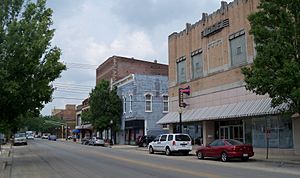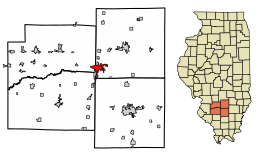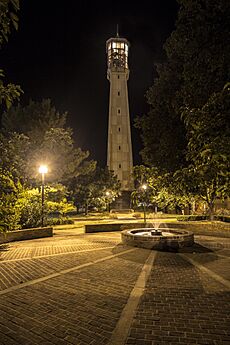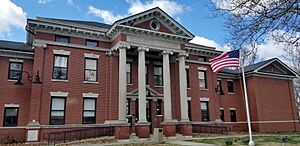Centralia, Illinois facts for kids
Quick facts for kids
Centralia, Illinois
|
||
|---|---|---|
 |
||
|
||

Location of Centralia in (clockwise) Clinton, Marion, Jefferson, and Washington Counties, Illinois.
|
||
| Country | United States | |
| State | Illinois | |
| Counties | Clinton, Jefferson, Marion, Washington | |
| Townships | Centralia, Brookside, Grand Prairie, Irvington |
|
| Founded | 1853 | |
| Named for | Illinois Central Railroad | |
| Government | ||
| • Type | Manager-Council | |
| • Body | City Council | |
| Area | ||
| • Total | 9.23 sq mi (23.91 km2) | |
| • Land | 8.20 sq mi (21.24 km2) | |
| • Water | 1.03 sq mi (2.67 km2) | |
| Elevation | 502 ft (153 m) | |
| Population
(2020)
|
||
| • Total | 12,182 | |
| • Density | 1,485.61/sq mi (573.61/km2) | |
| Demonym(s) | Centralian | |
| Time zone | UTC−6 (CST) | |
| • Summer (DST) | UTC−5 (CDT) | |
| ZIP Code(s) |
62801
|
|
| Area code(s) | 618,730 | |
| FIPS code | 17-12164 | |
| GNIS ID | 2393787 | |
| Public Transit | South Central Transit | |
| Wikimedia Commons | Centralia, Illinois | |
Centralia is a city in Illinois, a state in the United States. It is special because it is located in four different counties: Clinton, Jefferson, Marion, and Washington. Most of the city is in Marion County.
Centralia is the largest city in Clinton, Marion, and Washington counties. However, it is not the main city (county seat) for any of them. In 2020, about 12,182 people lived in Centralia.
Contents
History of Centralia
How Centralia Got Its Name
Centralia was named after the Illinois Central Railroad. This railroad was built in 1853. The city started where two main parts of the railroad met. Centralia officially became a city in 1859. Today, the railroad line is owned by Canadian National.
Important Land Marker
An important point for land surveys in Illinois is located in Centralia. This spot, called the Third Principal Meridian, was set up in 1815. It helps map out about 60% of Illinois, including the big city of Chicago. You can find a monument and a historical marker at this spot today.
Local Products and Culture
The famous PayDay candy bar started being made in Centralia in 1938. Later, in the 1990s, the candy bar factory closed. A film called The Big One (1998) by Michael Moore talked about this factory closing and how it affected the town.
Did you know there's another city named Centralia? The town of Centerville, Washington, changed its name to Centralia, Washington to avoid confusion. Someone who used to live in Centralia, Illinois, suggested the new name!
Centralia's City Flag
The city flag of Centralia was designed in 1924 by Wendell Bauer. He won a contest for his design. The flag has a wide red stripe in the middle, which stands for the railroads that helped the city grow. Gold stars above and below the stripe represent the area's mining and farming. There's also a triangle pyramid with a sphinx head, which is a nod to Southern Illinois' nickname, "Little Egypt."
Mining History
In 1947, a sad event happened called the Centralia mine disaster. A coal mine nearby exploded, and 111 people died. The folk singer Woody Guthrie wrote a song about it called "The Dying Miner."
Geography and Location
Centralia is about 60 miles (97 km) east of St. Louis, Missouri. Most of the city is in Marion County, but it also reaches into Clinton, Washington, and Jefferson counties.
Centralia is one of only three cities in Illinois that are located in four different counties. This unique location means parts of Centralia are connected to different economic areas. For example, the part in Marion County is its own "Micropolitan Statistical Area." The part in Clinton County is linked to the St. Louis Metropolitan Area.
The city covers a total area of about 9.23 square miles (23.91 km²). Most of this area is land, and a smaller part is water.
Population and People
Centralia's population has changed over the years. In 2020, there were 12,182 people living in the city.
The city has a mix of different groups of people. In 2020, about 77.92% of the people were White, 11.01% were African American, and 2.09% were Asian. About 3.29% of the population identified as Hispanic or Latino.
The average age in Centralia in 2020 was 40.8 years old. About 24.1% of the population was under 18 years old.
Arts and Culture
Centralia Cultural Society
The Centralia Cultural Society is a place where people can enjoy and create art. It is home to the Centralia Philharmonic Orchestra, which is an orchestra for amateur musicians. It also hosts the Little Theatre Players, who perform plays and musicals, and the Choral Society. The center also displays art from local photography and art clubs, as well as student art.
Local Attractions
Foundation Park is a popular spot. It hosts the yearly Balloon Fest, where about 40 hot air balloons gather and attract many visitors. During November and December, the park also has a "Fantasy of Lights" display, where you can drive through and see holiday lights.
Foundation Park also supports the Centralia Carillon. This carillon was finished in 1983 and has 65 bells, making it the eighth-largest in the world! The biggest bell, called Great Tom, weighs 5.5 tons.
Fairview Park has an old steam locomotive from the Illinois Central Railroad on display. It's one of only two left of its kind. You can also see a caboose and a rare F-105 Thunderchief aircraft there.
Historic Downtown Area
Centralia's downtown area has many historic buildings and has been updated recently. A fun new addition is a Splash Pad near the Centralia Carillon.
Downtown Historic Buildings
In 2012, the downtown area of Centralia was added to the National Register of Historic Places. This means it's recognized as an important historic area. Some notable old buildings include the Langenfeld Hotel, Centralia House restaurant, and the Illinois Theater.
The Langenfeld Hotel opened in 1912 and was known as the best hotel in the area. The Centralia Sentinel Building, which houses the local newspaper, has a unique Egyptian Revival style. This style might be linked to Southern Illinois being called "Egypt."
The Illinois Theater used to be a place for live shows and movies. It is being renovated so it can host professional performances again.
Centralia Area Historical Museum
The Centralia Area Historical Museum is a free museum with three floors of photos and items. It tells the story of Centralia's past as a big railway and mining town. The museum also has the George Ross Library, which contains books, newspapers, and family histories about the city.
Parks and Recreation
Centralia has several great parks and recreation spots:
- Foundation Park: This large 235-acre (0.95 km²) park has hiking trails, an exercise path, and two fishing ponds. It also features a restored prairie, a disc-golf course, and an outdoor amphitheater.
- Fairview Park: Here you'll find baseball and softball fields, tennis courts, a skate park, a swimming pool, and playgrounds.
- Centralia Recreational Complex: This is a big indoor facility with basketball courts, swimming pools, weight rooms, and exercise classes.
There are also two lakes near Centralia for water activities:
- Raccoon Lake: This is a man-made lake built in 1942. It's used for boating and fishing. It also hosts annual power boat races.
- Lake Centralia: Another man-made lake, built in 1910. It's a popular spot for boating and fishing, especially for bass, bluegill, and catfish. Fishing tournaments are often held here.
Education
Centralia has several schools for different age groups.
Public Schools
- Elementary Schools: Schiller Elementary (Pre-K to 1st grade) and Jordan Elementary (2nd to 3rd grade).
- Junior High School: Centralia Junior High School (4th to 8th grade).
- High School: Centralia High School. Their sports teams are called the Orphans and Annies.
Centralia High School's Unique Mascot
The Centralia High School boys' basketball team is famous for winning over 2,000 games, being the first high school team in the nation to do so! They are known as the "Orphans." This unique nickname came about in the early 1900s. The school didn't have much money, so the team had to wear mismatched red uniforms. An announcer at a state tournament said they looked like "a bunch of orphans," and the name stuck! In 2013 and 2014, USA Today named the Centralia Orphans the "Most Unique Mascot in the nation."
Private Schools
- Trinity Lutheran School: (Kindergarten to 8th grade)
- St. Mary School: (Preschool and Kindergarten to 8th grade)
- New Horizon Christian School: (Preschool and Kindergarten to 8th grade)
- Christ, Our Rock Lutheran High School: This private high school opened in 2004. Their teams are called the Silver Stallions.
Higher Education
- Kaskaskia College: This is a community college that serves Centralia and nearby towns. It offers many programs, including technical training at the Harry L. Crisp Technology Center. The college also has community education classes on various hobbies.
- Airgo International Flight School: Located at the Centralia Municipal Airport, this school trains people to become professional pilots.
Transportation
Centralia has good transportation links:
- Highways: Illinois Route 161 runs east-west, and U.S. Highway 51 runs north-south through the city.
- Public Transit: South Central Transit provides public bus service for Centralia and the surrounding areas.
- Airport: The city owns and runs the Centralia Municipal Airport, which is for private and corporate planes.
Train Travel
Amtrak, the national passenger train system, serves Centralia. You can catch trains like the City of New Orleans, which travels between Chicago and New Orleans. The Saluki and Illini trains also stop in Centralia, connecting the city to Chicago and Carbondale.
Notable People from Centralia
Many interesting people have come from Centralia, including:
- Chad Beguelin, a playwright nominated for Tony Awards
- David Blackwell, a famous statistician and the first Black member of the National Academy of Sciences
- James Brady, who was the press secretary for President Ronald Reagan
- Roland Burris, a former U.S. Senator for Illinois
- Gary Gaetti, a baseball player who won the World Series with the Minnesota Twins
- Adruitha Lee, an Academy Award-winning hairstylist
- Jean Madeira, an opera singer
- Kirk Rueter, a pitcher for the San Francisco Giants
- Nancy Scranton, a professional golfer
Images for kids
See also
 In Spanish: Centralia (Illinois) para niños
In Spanish: Centralia (Illinois) para niños









